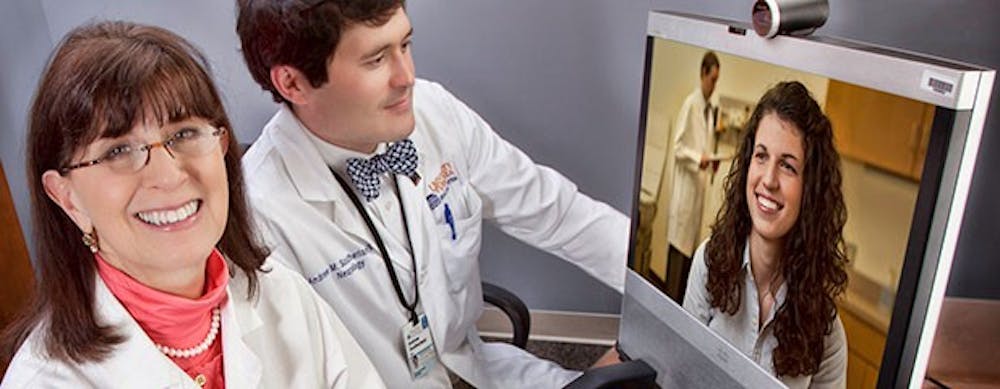Through the use of telemedicine, the University’s telestroke program is fostering ongoing communication and remote consultation to facilitate diagnosis and treatment of patients. More specifically, the use of telehealth at the Comprehensive Stroke Center acts as a mechanism to provide immediate care to stroke patients with the goal of increasing accessibility to healthcare across the state.
Telemedicine offers doctors and other providers the opportunity to diagnose and communicate with patients and other hospitals through the use of Health Insurance Portability and Accountability Act compliant technology. Two important components of telemedicine are videoconferencing — which allows for consultation and examination — and remote monitoring of vitals.
Dr. Karen Rheuban, pediatrician and the medical director of the Office of Telemedicine, founded the telehealth program at the University in the mid-1990s alongside Lt. Col. Eugene Sullivan and has since worked to expand the program to offer services in over 60 subspecialties of care.
Rheuban wrote in an email about how the University has used telemedicine to collaborate with smaller hospitals to optimize treatment and diagnosis processes.
“In many community settings the full range of specialty services may not be available,” Rheuban said. “Telemedicine allows for those services to be made available to patients and their providers as needed. In addition telehealth includes remote monitoring technologies that allow us to stay abreast of patients in their home or work settings.”
Dr. Nina Solenski, the director of the University’s telestroke program, discussed the implications of telehealth in the field of medicine and the benefits associated with using telemedicine for the diagnosis and treatment of stroke patients.
According to Solenski, by reaching out to hospitals and communities that may not have access to neurologists or vascular neurologists, the telestroke program utilizes the resources available at the University to provide 24/7 consultation and monitoring of patients through videoconferencing.
“You’ve got people who do this all the time, and they’re going to give you the best care possible — but for some of the smaller places, it’s not that they’re not giving good care, it’s just that they don’t have these kinds of tools to be able to do it as fast,” Solenski said. “The whole point is to evaluate people in particularly rural community hospitals and get them to the right places so that they have a chance.”
Videoconferencing allows doctors to speak with an on-site team at another hospital, examine patients with high definition imaging and track a patient’s distance from nearby hospitals where they could potentially seek care. After determining stroke severity in advance with the NIH Stroke Scale — a qualitative, standardized method of categorization — doctors are able to prepare for any necessary measures before patients arrive.
Expediting the removal of blood clots in the brain allows for faster treatment and preservation of brain function. When left untreated, the ischemic core of a stroke — an area with only 10 to 25 percent blood flow — can grow, causing irreparable damage which may lead to death or severe disability.
Solenski highlighted the repercussions of lost time in stroke treatment and the measures that are tracked to ensure quality care.
“Every minute millions of neurons are dying,” Solenski said. “So from that perspective, time is really important, so we have all sorts of metrics — did we answer the phone quickly, did we get onto the videoconference quickly, did we administer tPA, [tissue plasminogen activator], quickly, did we … evaluate a patient and say that this one needs to come to U.Va. or a higher tertiary to give thrombectomy and different procedures.”
The University’s Telestroke Center acts as the center of a wheel with six “spokes” or hospitals that the Center works with to optimize patient care. Recently, the Comprehensive Stroke Center performed its 1,000th telestroke consultation, marking a milestone and showcasing the benefits of telemedicine.
Since diabetes, hypertension, smoking and obesity are risk factors for both strokes and cardiovascular events, Solenski emphasized the importance of evaluating the resources available in communities and expressed her interest in expanding telestroke services into areas with high-risk of stroke occurrences.
“If you look at the resources people might have, so being close to a hospital, having broadband so you can get telehealth services … this place in Virginia — south-central — really pops out as having very little resources and very high risk,” Solenski said. “We’re trying to think about targeting this region.”
Solenski also discussed the future of telemedicine and the shift that it represents.
“What you’re basically doing, is instead of having a hospital and expecting patients to come to you as a specialist or even your own medicine, now you’re turning that model inside out and you’re taking it out to them,” Solenski said. “You can take it out to their nearest hospital but then the next wave … is to take it out to their homes.”







